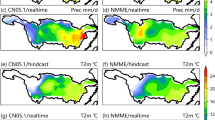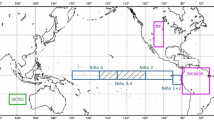Abstract
Given observed initial conditions, how well do coupled atmosphere–ocean models predict precipitation climatology with 1-month lead forecast? And how do the models’ biases in climatology in turn affect prediction of seasonal anomalies? We address these questions based on analysis of 1-month lead retrospective predictions for 21 years of 1981–2001 made by 13 state-of-the-art coupled climate models and their multi-model ensemble (MME). The evaluation of the precipitation climatology is based on a newly designed metrics that consists of the annual mean, the solstitial mode and equinoctial asymmetric mode of the annual cycle, and the rainy season characteristics. We find that the 1-month lead seasonal prediction made by the 13-model ensemble has skills that are much higher than those in individual model ensemble predictions and approached to those in the ERA-40 and NCEP-2 reanalysis in terms of both the precipitation climatology and seasonal anomalies. We also demonstrate that the skill for individual coupled models in predicting seasonal precipitation anomalies is positively correlated with its performances on prediction of the annual mean and annual cycle of precipitation. In addition, the seasonal prediction skill for the tropical SST anomalies, which are the major predictability source of monsoon precipitation in the current coupled models, is closely link to the models’ ability in simulating the SST mean state. Correction of the inherent bias in the mean state is critical for improving the long-lead seasonal prediction. Most individual coupled models reproduce realistically the long-term annual mean precipitation and the first annual cycle (solstitial mode), but they have difficulty in capturing the second annual (equinoctial asymmetric) mode faithfully, especially over the Indian Ocean (IO) and Western North Pacific (WNP) where the seasonal cycle in SST has significant biases. The coupled models replicate the monsoon rain domains very well except in the East Asian subtropical monsoon and the tropical WNP summer monsoon regions. The models also capture the gross features of the seasonal march of the rainy season including onset and withdraw of the Asian–Australian monsoon system over four major sub-domains, but striking deficiencies in the coupled model predictions are observed over the South China Sea and WNP region, where considerable biases exist in both the amplitude and phase of the annual cycle and the summer precipitation amount and its interannual variability are underestimated.












Similar content being viewed by others
References
Annamalai H, Liu P (2005) Response of the Asian summer monsoon to changes in El Nino properties. Q J R Meteorol Soc 131:805–831
Annamalai H, Slingo JM, Sperber KR, Hodges K (1999) The mean evolution and variability of the Asian summer monsoon: comparison of ECMWF and NCEP-NCAR reanalyses. Mon Weather Rev 127:1157–1186
Annamalai H, Hamilton K, Sperber KR (2007) The south Asian summer monsoon and its relationship with ENSO in the IPCC AR4 simulation. J Clim 20:1071–1092
Battisti DS, Hirst AC (1989) Interannual variability in the tropical atmosphere–ocean system: influence of the basic stated, ocean geometry, and non-linearity. J Atmos Sci 46:1687–1712
Chang CP, Wang Z, McBride J, Liu CH (2005) AC of Southeast Asia–Maritime Continent rainfall and the asymmetric monsoon transition. J Clim 18:287–301
Delecluse P, Madec G (1999) Ocean modeling and the role of the ocean in the climate system. In: Holland WR, Joussaume S, David F (eds) Modeling the Earth’s climate and its variability, Les Houches 1997, Elsevier Science, Amsterdam
Delworth TL et al (2006) GFDL’s CM2 global coupled climate models—Part I: formulation and simulation characteristics. J Clim 19:643–674
Deque M (2001) Seasonal predictability of tropical rainfall: probabilistic formulation and validation. Tellus 53A:500–512
Fennessy MJ, Kinter JL III, Kirtman B et al (1994) The simulated Indian monsoon: a GCM sensitivity study. J Clim 7:33–43
Fu X, Wang B (2004) The boreal-summer intraseasonal oscillations simulated in a hybrid coupled atmosphere-ocean model. Mon Weather Rev 132:2628–2649
Gadgil S, Sajani S (1998) Monsoon precipitation in the AMIP runs. Clim Dyn 14:659–689
Goswami BN, Wu G, Yasunari T (2006) The AC, intraseasonal oscillations, and roadblock to seasonal predictability of the Asian summer monsoon. J Clim 19:5078–5099
Gregory D, Morcrette JJ, Jakob C, Beljaars ACM, Stockdale T (2000) Revision of convection, radiation and cloud schemes in the ECMWF Integrated Forecasting System. Q J R Meteorol Soc 126:1685–1710
Jin EK, Kinter JL, Wang B, Park CK, Kang IS et al (2008) Current status of ENSO prediction skill in coupled ocean–atmosphere models. Clim Dyn 31:647–664
Kanamitsu M, Ebisuzaki W, Woollen J, Yang S-K, Hnilo JJ, Fiorino M, Potter GL (2002) NCEP-DOE AMIP-II Reanalysis (R-2). Bull Am Meteorol Soc 83:1631–1643
Kang IS, Ho CH, Lim YK, Lau KM (1999) Principal modes of climatological, seasonal, and intraseasonal variations of the Asian summer monsoon. Mon Weather Rev 127:322–340
Kang IS, Jin K, Wang B, Lau KM, Shukla J et al (2002) Intercomparison of the climatological variations of Asian summer monsoon precipitation simulated by 10 GCMs. Clim Dyn 19:383–395
Kitoh A, Arakawa O (1999) On overestimation of tropical precipitation by an atmospheric GCM with prescribed SST. Geophys Res Lett 26:2965–2968
Kug J-S, Kang I-S, Choi D-H (2008) Seasonal climate predictability with tier-one and tier-two prediction system. Clim Dyn 31:403–416. doi:10.1007/s00382-007-0264-7
Kumar KK, Hoerling M, Rajagopalan B (2005) Advancing Indian monsoon rainfall predictions. Geophys Res Lett 32:L08704
Lau NC, Nath MJ (2000) Impact of ENSO on the variability of the Asian–Australian monsoon as simulated in GCM experiments. J Clim 13:4287–4309
Li T, Hogan TF (1999) The role of the annual-mean climate on seasonal and interannual variability of the Tropical Pacific in a coupled GCM. J Clim 12:780–792
Luo J-J, Masson S, Behera S, Shingu S, Yamagata T (2005) Seasonal climate predictability in a coupled OAGCM using a different approach for ensemble forecasts. J Clim 18:4474–4497
Madec G, Delecluse P, Imbrad M, Levy C (1997) OPA release 8, Ocean general circulation model reference manual. LODYC Internal Report, Paris
Madec G, Delecluse P, Imbrad M, Levy C (1998) OPA version 8.1, Ocean general circulation model reference manual. LODYC Technical Report No. 11, Paris
Marsland SJ, Haak H, Jungclaus J-H, Latif M, Roske F (2003) The Max-Planck-Institute global ocean/sea ice model with orthogonal curvilinear coordinates. Ocean Model 5:91–127
Mechoso CR, Robertson AW, Barth N, Davey MK, Delecluse P, Gent PR et al (1995) The seasonal cycle over the tropical Pacific in coupled atmosphere-ocean general circulation models. Mon Weather Rev 123:2825–2838
Meehl GA, Arblaster JM, Loschnigg J (2003) Coupled ocean–atmosphere dynamical processes in the tropical Indian and Pacific Oceans and the TBO. J Clim 16:2138–2158
Nanjundiah RS, Vidyunmala V, Srinivasan J (2005) On the difference in the seasonal cycle of rainfall over India in the community climate system model (CCSM2) and community atmospheric model (CAM2). Geophys Res Lett 32:L20720. doi:10.1029/2005GL024278
Palmer TN, Alessandri A, Andersen U, Cantelaube P, Davey M et al (2004) Development of a European multi-model ensemble system for seasonal to interannual prediction (DEMETER). Bull Am Meteor Soc 85:853–872
Roeckner E, Arpe K, Bengtsson L, Christoph M, Claussen M, Dumenil L, Esch M, Giorgetta M, Schlese U, Schulzweida U (1996) The atmospheric general circulation model ECHAM4: model description and simulation of present-day climate. Max Planck Institut fur Meteorologie, Report No. 218, Hamburg, Germany
Saha S, Nadiga S, Thiaw C, Wang J et al (2006) The NCEP climate forecast system. J Clim 19:3483–3517
Schopf PS, Suarez MJ (1988) Vacillations in a coupled ocean–atmosphere model. J Atmos Sci 45:549–566
Smith TM, Reynolds RW (2004) Improved extended reconstruction of SST (1854–1997). J Clim 17:2466–2477
Sperber KR, Palmer TN (1996) Interannual tropical rainfall variability in general circulation model simulations associated with the atmospheric model intercomparison project. J Clim 9:2727–2750
Sperber KR, Slingo JM, Annamalai H (2000) Predictability and the relationship between subseasonal and interannual variability during the Asian summer monsoon. Q J R Meteorol Soc 126:2545–2574
Sperber KR et al (2001) Dynamical seasonal predictability of the Asian summer monsoon. Mon Weather Rev 129:2226–2248
Turner AG, Inness PM, Slingo JM (2005) The role of the basic state in the ENSO-monsoon relationship and implications for predictability. Q J R Meteorol Soc 131:781–804
Uppala SM, Kållberg PW, Simmons AJ, Andrae U, da Costa Bechtold V et al (2005) The ERA-40 re-analysis. Q J R Meteorol Soc 131:2961–3012
Vintzileos A, Delecluse P, Sadourny R (1999) On the mechanisms in a tropical ocean–global atmosphere coupled general circulation model. Part II: interannual variability and its relation to the seasonal cycle. Clim Dyn 15:63–80
Waliser DE, Jin K, Kang IS et al (2003a) AGCM simulations of intraseasonal variability associated with the Asian summer monsoon. Clim Dyn 21:423–446
Waliser DE, Stern W, Schubert S, Lau KM (2003b) Dynamic predictability of intreaseasonal variability associated with the Asian summer monsoon. Q J R Meteorol Soc 129:2897–2925
Wang B, Ding Q (2006) Changes in global monsoon precipitation over the past 56 years. Geophys Res Lett 33:L06711. doi:10.1029/2005GL025347
Wang B, Ding Q (2008) The global monsoon: major modes of annual variation in tropical precipitation and circulation. Dyn Atmos Ocean 44:165–183
Wang B, Lin Ho (2002) Rainy season of the Asian–Pacific summer monsoon. J Clim 15:386–398
Wang B, Kang I-S, Lee J-Y (2004) Ensemble simulations of Asian–Australian monsoon variability by 11 AGCMs. J Clim 17:803–818
Wang B, Ding QH, Fu XH, Kang I-S, Jin K, Shukla J, Doblas-Reyes F (2005a) Fundamental challenge in simulation and prediction of summer monsoon rainfall. Geophys Res Lett 32:L15711
Wang W, Saha S, Pan HL, Nadiga S, White G (2005b) Simulation of ENSO in the new NCEP coupled forecast system model. Mon Weather Rev 133:1574–1593
Wang B, Lee JY, Kang IS, Shukla J, Hameed SN, Park CK (2007) Coupled predictability of seasonal tropical precipitation. CLIVAR Exch 12:17–18
Wang B, Lee JY, Kang IS, Shukla J, Park CK et al (2008) How accurately do coupled climate models predict the Asian–Australian monsoon interannual variability? Clim Dyn 30:605–619. doi:10.1007/s00382-007-0310-5
Wang B, Lee JY, Kang IS, Shukla J, Park CK et al (2009) Assessment of the APCC/CliPAS 14-model ensemble retrospective seasonal prediction (1980–2004). Clim Dyn 33:93–117
Webster PJ (2006) The coupled monsoon system. In: Wang Bin (ed) The Asian Monsoon, Springer
Webster PJ, Magana VO, Palmer TN, Shukla J, Tomas RA, Yanai M, Yasunari T (1998) Monsoons: processes, predictability, and the prospects for prediction. Geophys Res Lett 103:14451–14510
Wolff JE, Maier-Reimer E, Legutke S (1997) The Hamburg Ocean primitive equation model. In: Deutsches Klimarechenzentrum Tech. Rep. 13, Hamburg, Germany
Wu R, Kirtman B (2005) Roles of Indian and Pacific Ocean air–sea coupling in tropical atmospheric variability. Clim Dyn 25:155–170
Xie P, Arkin PA (1997) Global precipitation: A 17-year monthly analysis based on gauge observations, satellite estimates, and numerical model outputs. Bull Am Meteorol Soc 78:2539–2558
Zhong A, Hendon HH, Alves O (2005) Indian Ocean variability and its association with ENSO in a global coupled model. J Clim 18:3634–3649
Acknowledgments
This research was supported by APEC Climate Center (APCC) as a part of APCC International research project and the Korean meteorological Administration Research and Development Program under Grant CATER 2009-1146. Lee and Wang acknowledge support from IPRC, which is in part supported by JAMSTEC, NOAA (grant No. NNX07AG53G), and NOAA (grant No. NA09OAR4320075). This is the IPRC publication 703 and SOEST publication 7947.
Author information
Authors and Affiliations
Corresponding author
Rights and permissions
About this article
Cite this article
Lee, JY., Wang, B., Kang, IS. et al. How are seasonal prediction skills related to models’ performance on mean state and annual cycle?. Clim Dyn 35, 267–283 (2010). https://doi.org/10.1007/s00382-010-0857-4
Received:
Accepted:
Published:
Issue Date:
DOI: https://doi.org/10.1007/s00382-010-0857-4




